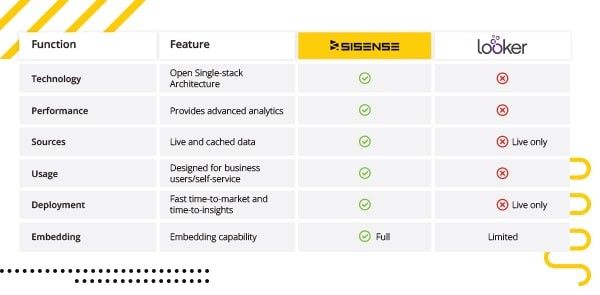
Choosing the Right BI Tool: Sisense vs. Looker

Introduction to Sisense
Sisense is a robust and user-friendly BI tool that enables businesses to analyze complex data sets and extract meaningful insights. With its advanced features and intuitive interface, Sisense empowers users to transform raw data into actionable information, helping them make informed decisions and drive organizational growth.
An Overview of Looker
Looker is a modern data platform that empowers organizations to access, analyze, and share data in an intuitive and collaborative manner. It provides a unified view of data from various sources, allowing users to explore and understand complex datasets effortlessly.
Comparing Features and Functionality
Data Connectivity and Integration
- Sisense offers seamless connectivity to a wide range of data sources, including databases, cloud applications, spreadsheets, and more. It supports both structured and unstructured data, ensuring that users can access and analyze all relevant information efficiently.
- Looker, on the other hand, provides native connectors to popular databases and cloud platforms. It also offers a robust API that allows users to integrate data from multiple sources, enabling a comprehensive view of business data.
Data Visualization and Reporting
- Both Sisense and Looker offer powerful data visualization and reporting capabilities. Sisense provides a drag-and-drop interface, allowing users to create interactive dashboards and reports without the need for coding. Its extensive library of visualizations and widgets enables users to present data in compelling ways.
- Looker also offers a wide range of visualization options and enables users to build custom visualizations using JavaScript. Its intuitive exploration interface allows users to drill down into data and uncover insights effortlessly.
Ad-Hoc Analysis and Self-Service BI
- Sisense excels in the area of ad-hoc analysis and self-service BI. Its easy-to-use interface and powerful data modeling capabilities empower users to explore data independently and uncover hidden insights. With Sisense, users can create ad-hoc queries, apply filters, and perform calculations without relying on IT or data analysts.
- Looker also offers self-service data exploration and ad-hoc analysis features. Its unique data modeling layer allows users to build custom dimensions and metrics on the fly, providing flexibility and agility in data analysis.
Collaboration and Embedded Analytics
- Both Sisense and Looker offer collaboration features that enable users to share data, insights, and reports with team members. Sisense allows users to collaborate within the platform by leaving comments, sharing dashboards, and scheduling reports.
- Looker provides embedded analytics capabilities, allowing users to embed interactive reports and dashboards within external applications or websites. This feature enables organizations to share data and insights with stakeholders seamlessly.
Scalability and Performance
- Scalability and performance are crucial factors to consider when selecting a BI tool. Sisense is known for its high performance, enabling users to process and analyze large volumes of data quickly. Its in-chip technology, powered by an Elastic Data Hub, ensures fast query response times even with complex data sets.
- Looker, on the other hand, offers a scalable architecture that can handle massive amounts of data. Its in-memory caching technology enhances performance, allowing users to access and analyze data in real-time.
Choosing the Right BI Tool: Sisense vs. Looker
When it comes to selecting a BI tool, there is no one-size-fits-all solution. The choice between Sisense and Looker depends on your specific needs, budget, and organizational requirements. Here are some key factors to consider:
- Complexity of data analysis: If your organization deals with highly complex data sets and requires advanced data modeling capabilities, Sisense may be the better choice.
- Ease of use: If you are looking for a tool that offers a user-friendly interface and requires minimal technical expertise, Looker’s intuitive exploration features might be more suitable.
- Collaboration requirements: Consider whether you need collaboration features or embedded analytics capabilities in your BI tool.
- Scalability and performance: Evaluate the scalability and performance requirements of your organization to ensure that the chosen tool can handle your data volume and processing needs.
- Cost considerations: Compare the pricing models and licensing options offered by Sisense and Looker to determine which aligns better with your budget.
Ultimately, both Sisense and Looker are powerful BI tools that can provide valuable insights and help drive business growth. It’s crucial to evaluate your specific needs and conduct a thorough analysis of the features and capabilities of each tool before making a decision.